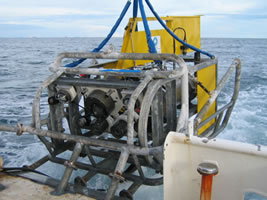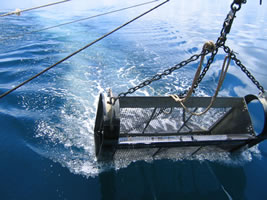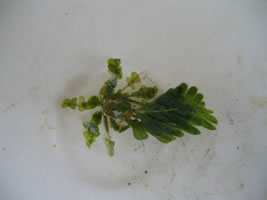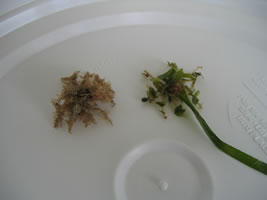|
We are on board the RV James
Kirby in the Torres Strait doing seabed diversity studies.
A typical day starts about 6:30
when the skipper starts the motor, with the oil pressure alarm
waking everyone from their slumber. The Deckhand bolts out of
bed and raises the anchor, then it’s usually about half
an hour to the first site.
On this trip we have three marine
biologists: one from CSIRO Cleveland, one from QDPI and one
from Queensland Museum (that’s me!). We also have a technician
from CSIRO who keeps the computers, cameras and fibre optics
running.
Once at the site we lower the Dropcam
over the edge to the bottom of the sea bed (which for a lot
of the sites we visited in the Torres Straits is about 15 m).

Slowly we run the camera over a
transect of the terrain, recording flora and fauna for 500m.
We then haul the dropcam back on board do a u-turn and drop
the sled in the water and go back over the same site.

The ‘catch’ gets hauled
on board and we start sorting the samples whilst the skipper
steams onto the next site. We are aiming for about 120 sites
over this two week cruise.

The catch is basically sorted into
phyla, photographed, weighed and then frozen or preserved. By
this time we are usually at the next site and so we repeat the
same procedure.
We do somewhere between 7 and 11
sites a day. Sometimes this means we anchor between islands
and watch the sunset, but other days we might not finish the
sites until 9:30pm at night with waves crashing over the deck
and you get soaked sorting the samples.
But the real work will be doing
the analysis back at the lab, Identifying the samples to species
level. There are some delightful creatures brought on board
such as decorator crabs, seahorses and for me sponges like Clathria
basilana (sponge nerd).


How did I become a marine biologist?
A long and convoluted story. I did a science degree at UQ, then
an honours research year followed by a PhD in the field of molecular
genetics in plant pathology.
After the PhD I took a break from
science and did some work at Channel 9 as science communicator
on “why?”. Then I worked for two years as a research
scientist in the QUT physics department doing research on natural
lighting and solar hot water system design.
After that I worked as a shop assistant
at Mountain designs before taking up a plant pathologist position
at DPI in Cairns. I then had 6 months of travelling before I
had another science communication job this time with the Queensland
Museum Science Centre Roadshow, until I got my current job as
marine biologist with the Queensland Museum.
|